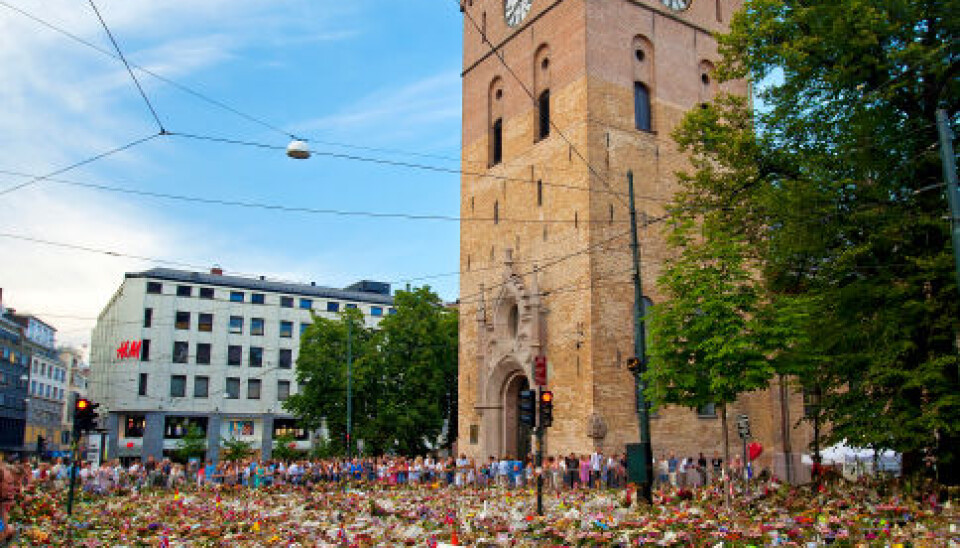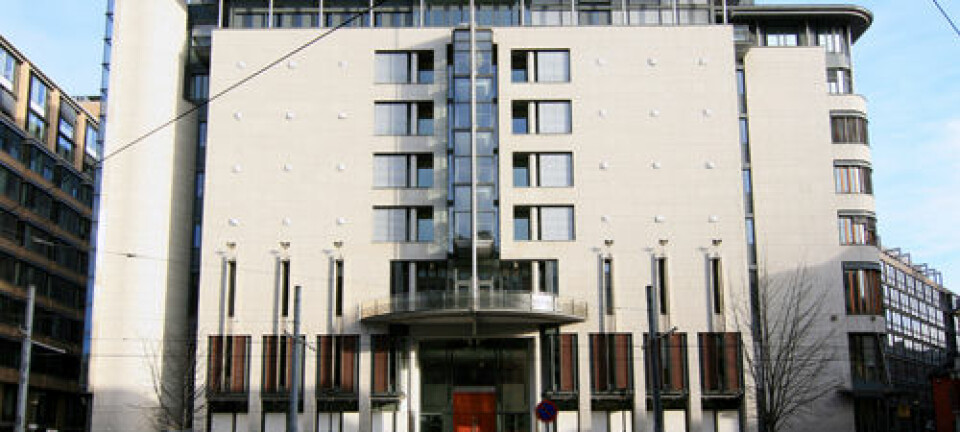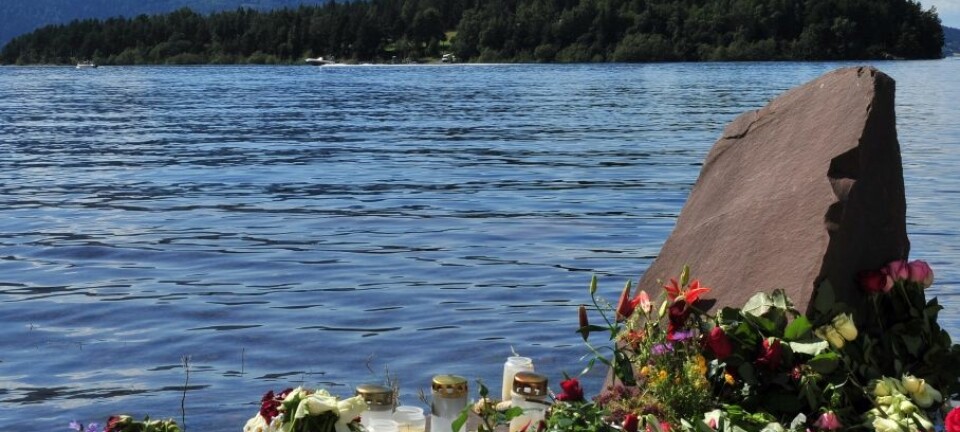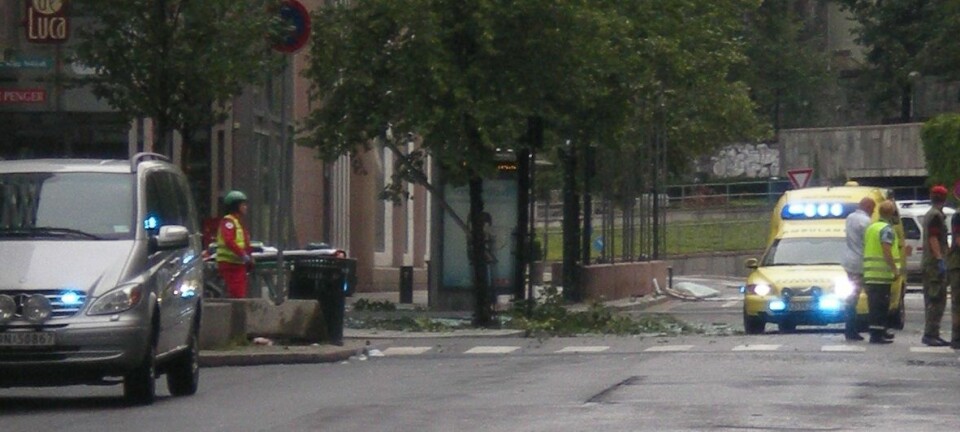
Oslo Cathedral was a likely focal point for grief
Oslo Cathedral quickly became a national site for expressing bereavement after the terror attack in Norway last year. People return to religion when faced with death and chaos, says researcher.
Denne artikkelen er over ti år gammel og kan inneholde utdatert informasjon.
A church in downtown Oslo didn’t have to be the spot where people showed sympathy and solidarity with flowers for the victims of the terrorist attacks on 22 July.
For instance they could have used the space outside the City Hall or some other neutral spot with no religious connections.
“If the terrorist attack had occurred for instance on a Monday, there would have been more time for planning and choosing another site, perhaps with an interfaith platform,” says Olaf Aagedal at the KIFO Research Centre.
“Cathedrals didn’t play the same central role in other Norwegian cities,” he explains.
Some key words

At a workshop this week on public mourning following 22 July, Aagedal presented the results of his study carried out in the Church of Norway.
“The findings indicate that the public readily retreats to the rituals of the national church when a crisis strikes society,” says Aagedal.
How do sites of mourning crop up?
“The time, place, tempo and timing are key words when explaining where they get established,” says KIFO researcher.

His field of research encompasses culture, religion sociology, rites, and the church.
“It’s partly a matter of the place, and partly an issue of the day of the week and time of day,” says Aagedal.
Not incidental
It wasn’t incidental that the Oslo Cathedral and the area around it became the focal point.
“It has served as a national ceremonial arena during royal funerals and weddings. But the spot where grief was expressed in Oslo didn’t have to be a church.”
“For instance when King Olav died in 1991 people streamed to the Royal Palace and lit candles on the front square during the days before the funeral,” says Aagedal.
The KIFO researcher has conducted in-depth interviews with staff at the Oslo Cathedral. His analysis shows that the speed and order in which things occur are much more salient for the result than expected.
“There’s a huge need to establish a grieving site quickly, especially in a situation where terror can create anxiety and chaos. On this particular afternoon the Oslo Cathedral was in what you could call a state of readiness,” says Aagedal.
Night-open cathedral planned 22 July
The Government building complex was bombed on Friday afternoon and a little later the bomber, disguised as a policeman, made his way to the summer camp of the Labour Party’s youth organisation at Utøya Island and gunned down scores of kids.
“The cathedral is just a short walk from the government buildings and it has maintained a tradition of keeping its doors open on Friday afternoon and throughout the night,” says Aagedal.
“The Trinity Church is even closer but it ended up inside the initial police barricades and couldn’t be used,” he says.
Just after the bomb exploded outside the Prime Minister’s Office Building the Oslo Cathedral was scheduled to open its doors – from 4 PM until early Saturday morning.
“The lighting of candles is a ritual element of all-night church vigils.”
Determined to reopen church
The cathedral had to close that evening and night. But plans had been made and the staff was prepared.
“In the immediate hours afterward the church couldn’t let the public in because of security considerations. But it was decided that it would open as soon as possible, which was in the morning on 23 July,” says Aagedal.
The employees at the Oslo Cathedral were determined to reopen the church and to hold Sunday service on 24 July.
They thought anything else would be a failure to perform their duty.
High mass became a national ceremony
This church service was initially planned as a normal high mass. The extraordinary circumstances made it change character entirely.
“When the Royal Family, the Prime Minister and the Government said they would attend, this actually became the first national mourning ceremony.”
“As everything happened at such a fast pace, the Oslo Cathedral became established as the national bereavement site,” says Aagedal.
Norway’s political leadership had a need to quickly demonstrate that society’s security and stability had been maintained.
“Thus the ordinary church service that had been planned by the Oslo Cathedral turned out to be a great opportunity for Norwegian officials and the public to express their sorrow and sympathy, and also express that we as a nation were not caving in, we stand by our values,” says Aagedal.
Extra openness and interest
The researcher thinks this has created more openness and interest for religious spaces after 22 July.
“This includes a variety of religious places and the opportunities for common ritualising in times of social crisis,” says Aagedal.
Although most Norwegian churches are fairly empty during normal Sunday services, Norwegians haven’t become so secular as a nation that the country’s churches and religion have lost significance.
At least not in times of crisis.
“Although most people are not regular churchgoers, the Norwegian Church concerns a lot of people and is in their consciousness. For example, nine out of ten Norwegians have church funerals.”
“When the nation is struck by mayhem and death religion is something to retreat to,” says sier Aagedal.
Believers or not
Aagerdal points out there’s a difference between accidents and terrorist attacks because terror creates more chaos and provokes stronger emotions and fears.
“In such highly uncertain situations the church room and spaces can promote feelings of security – whether one believes in God or not.”
“Religion is one aspect of this, the other is the community with others who are impacted by the catastrophe, their spontaneous emotional reactions and the need for a place where they can be together with others,” says Aagedal.
Translated by: Glenn Ostling

































